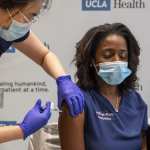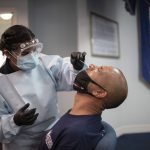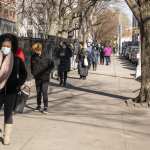For Joan Phillips, the hardest part was seeing her patients on a stretcher, the paramedics carrying them away, the doors of the ambulance closing behind them. When her nursing home patients got COVID-19, they couldn’t stay in the nursing assistant’s care — they could infect others. They had to be taken to the hospital.
Phillips worried about who would coax them to eat or cheer them up. She worried that the virus could take them away in a flash. She always thought, as she watched the ambulance pull away, about holding their hands again when they returned.
But none of them did.
“It’s so heart-wrenching sometimes when you do your best and you have to say goodbye,” said Phillips, who has been a certified nursing assistant in Miami for 17 years. “You’ve been working with a resident and a patient for so long and suddenly, the virus pushes them under.”
It has been the year of caregiving. And the year of loss.
The nation’s caregivers — nursing home assistants, home care aides, child care workers and the 50 million Americans caring for older relatives — have endured a nightmarish year. The workers, who are predominantly women, have taken on increased risk of coronavirus exposure to keep doing their jobs while keeping those they care for safe, often with little protection. Many have reported financial hardship and psychological strain as a result.
“We need more care than ever before … and the only infrastructure we have in place is underpaid, undervalued Black and Brown women and overstretched working women who are family caregivers. It’s just completely unsustainable,” said Ai-jen Poo, the co-founder and executive director of the National Domestic Workers Alliance and co-director of Caring Across Generations, a nonprofit advocating for family caregivers.
If there is one silver lining to this, it’s that the role of caregivers, whose labor has often gone unrecognized, is now coming into clearer focus. Hundreds of thousands of women have left the labor force due to caregiving responsibilities. The issue has grown so large and disruptive to the economy that the national discourse on the value of care work has started to shift. President Joe Biden first outlined his 10-year caregiving plan in July, much of it aimed at expanding community- and home-based care, creating more jobs and increasing wages for providers.
The first step in achieving these goals, however, is getting the workforce vaccinated.
Vaccine eligibility varies from state to state, but health care workers generally qualify for an early-round immunization. Thirty-nine states have included child care workers as a priority group for vaccination, along with K-12 teachers. And some states — such as Massachusetts and Georgia — list unpaid family caregivers as eligible for early vaccination, citing the role they play in protecting older people, who are at highest risk of COVID-19 complications and mortality.
But there are obstacles. Vaccine hesitancy remains a big concern, particularly among women of color, who make up 80 percent of home health aides, personal care aides and nursing assistants and 39 percent of the child care workforce. Polling suggests that women in general are more likely to have reservations about the vaccine; for Black women and Latinas, experts trace those reservations back to limited outreach by the medical system and a history of systemic racism and experimentation on people of color.
Beyond skepticism, determining where and when one is eligible can be a Herculean challenge caregivers are dealing with twice over — figuring out when their charges qualify for the two-shot regimen and determining if their work makes them eligible, too. It’s an unequal burden: Black women and Latinas are also less likely to know where or when they will be able to get a vaccine.
As a result, caregivers who have been vaccinated told The 19th that they feel dual responsibilities. First, to use their newfound immunity to continue caring for their patients. And second, to proselytize the vaccines, serving as unofficial ambassadors to alleviate their peers’ anxieties and help them navigate the often overwhelming sign-up system.
Phillips, 57, was the first in the nursing home where she works to volunteer to receive the vaccine. The others looked at her skeptically — Are you sure, Joan?
She got both her shots earlier this year with only mild symptoms. After, she said she felt like “a celebrity.” Her coworkers called her brave. But the logic was simple for her.
“I have to protect myself to protect others,” she said. “When I started, that’s when everybody followed behind me.”
Immunizing people like Phillips is one of the best ways to combat vaccine hesitancy, experts told The 19th. People who are nervous about the vaccine — worried about safety, whether it’s been adequately tested or if the side-effects are dangerous — are more likely to feel comfortable getting injected if someone they personally know and trust has already gone through the process. Recent polling suggests that among health care workers, vaccine skepticism has decreased as more workers complete the vaccination regimen.
But access remains a challenge. The number of people eligible for a COVID-19 vaccine exceeds the number of doses available. As of this writing, about 13.5 million vaccines will be made available to states each week, and virtually all are being administered. For many caregivers — even those whose work makes them a vaccine priority group — getting a vaccine is based almost on luck. That’s especially so for those who don’t work in big hospitals or nursing home facilities.
Susie Rivera, a 63-year-old home care worker in New Braunfels, Texas, counts herself among the fortunate. A woman she works for fought to make sure all her home care providers got immunized so that they could safely come back to work.
“She advocated for us, she got us all vaccinated,” she said. But in general, “if you’re a caregiver and going to someone’s house, they don’t have nothing for them.”
Rivera has worked in her field for decades, experience that translates to her now earning about $15 an hour, higher than the median wage of $12.15 for home care workers in 2019. That means she can help her colleagues buy protective equipment, which is rarely provided on the job. The same client who helped her get vaccinated also provides paid leave and pays for Rivera’s health insurance — benefits that are critical in a pandemic but practically unheard of in her field.
Even after getting vaccinated, Rivera is still taking every precaution. It’s not fully clear if she could still transmit the virus to someone else, despite being vaccinated herself. And the people in her orbit are distinctly vulnerable. Beyond her professional duties, she is the principal caregiver for her wife, who has rheumatoid arthritis, fibromyalgia and diabetes — conditions that elevate the risk of complications of COVID-19. Rivera’s father died last November, and now she also cares for her mother, who has end-stage hepatitis.
Having a vaccine offers her some relief, she said. Now she’s working to help her peers get vaccines as well.
“I have other coworkers and I tell them, ‘if you come across [a vaccine] and they’ll offer it to you — take it.’ There’s a lot of misconceptions, but I tell them, ‘No, you need to get it,’” Rivera said.
Rivera doesn’t stop with her coworkers. She feels that no one is trying to make inroads in her community and help people feel equipped to get a COVID-19 vaccine, even if they are eligible.
“I’m educating our community. There’s nothing out there for them. There’s no resources,” Rivera said. “They need to go to these communities with a community health center and talk to them. Get people in Spanish.”
In an effort to reach more Black and Latinx people, the Biden administration has launched an initiative to distribute vaccines through community health centers, which predominantly serve low-income people and focus on people of color. But implementing that initiative will take time, and it’s only targeted to 250 community health centers — a fraction of the 1,300 such clinics that exist around the country.
Long-term, Biden and his economic advisers are also looking at ways to ease some of the strain on the caregiving industry as a whole, so workers have more resources and better pay. His 10-year caregiving plan would add 150,00 community health workers, for instance, and provide paid leave so workers can take time to get vaccines or address other caregiving needs.
“For so long, we’ve been in a situation where people who need those services are growing aging populations and people with disabilities — and they just haven’t been able to get them,” said Poo, whose organization is advocating for the caregiving plan. “And then the workers who provide those services haven’t been able to survive in those jobs.”
Paid caregivers are only one part of the equation. An AARP analysis from last June found that more than one in five Americans had assumed unpaid work, caring for their more vulnerable family members. Between September and November alone, there was a 144 percent increase in the number of care-related work absences as compared to the same period in 2019, according to an analysis by the Center for American Progress, a progressive think tank.
The majority of those caregivers are women. For them, too, vaccination offers hope that the worst may be ending — but also a complex system to navigate.
Alex Villegas, 31, has over the past year assumed a full-time role taking care of her mother, who has multiple brain conditions and needs help with day-to-day functions. Villegas, who is simultaneously pursuing a masters degree, has support from her stepfather, who is 78, and an aide they’ve hired for help. But the work is nonetheless demanding.
When vaccines became available in San Diego County, it fell on Villegas to figure out whether and how her mother could qualify — and whether she could as well.
“The vaccine serves a very practical purpose. In my caregiving experience, and in this pandemic, I’ve been the one going to get our groceries, to pick up our packages from the post office,” Villegas said. “The few times we’ve had to go to the emergency room, or an in-person appointment for my mom, I’ve been the one to go be with her, since she’s not able to go by herself.”
It’s not yet fully clear whether either available COVID-19 vaccine will prevent the recipient from being a carrier for the virus, and then transmitting it to someone else. But scientists, including Anthony Fauci, the nation’s top infectious disease doctor, say the early data looks promising. And for Villegas, getting a vaccine matters for another reason: If she fell ill, who would take over her responsibilities at home?
But finding a vaccine appointment — and figuring out her own eligibility — was a mammoth challenge.
“I just realized I had to keep checking every day. I’m savvy with the Internet,” she said. “But a lot of folks don’t have the time or resources or access to a computer.”
Finally, she found a vaccination clinic at a nearby fire station. She pored over articles and websites to verify that, despite her unpaid role, her work helping her mother qualified her, at least in her specific region. The work has paid off: She, her mother, her stepfather and the aide helping care for her mother have all gotten vaccines.
But it’s also clear, she said, that not everyone has the resources or time to spend as much time researching as she did. She’s particularly worried about other people close to her parents’ age.
“Communicating with my mom’s friends who are also of her age and less privy to the technology — I’ve offered my assistance to help them schedule an appointment,” Villegas said. “But it makes me concerned. I just feel like more resources are needed in the outreach effort to reach the older generation, to reach individuals who are ill or disabled or homebound.”





